Liebherr WF1061 Installation Guide

Installation Instructions
Refrigerators and freezers, built-in
Instructions de montage
Réfrigérateurs et congélateurs, encastrables
Instrucciones de montaje
Frigoríficos y congeladores, empotrables
WF 1061/ BF 1061 081113 7084598 - 01

General safety information
Contents |
|
|
1 |
General safety information........................... |
2 |
2 |
Setting up the appliance............................... |
2 |
3 |
Planning information..................................... |
4 |
4 |
Cabinet Opening Dimensions...................... |
6 |
5 |
Air circulation in the kitchen cabinet........... |
6 |
6 |
Door swing clearance................................... |
7 |
7 |
Changing the door hinges............................ |
10 |
7.1 |
Remove soft stop mechanism (top).................. |
10 |
7.2 |
Remove soft stop unit (bottom)........................ |
10 |
7.3 |
Remove upper door......................................... |
11 |
7.4 |
Remove lower door.......................................... |
11 |
7.5 |
To swap over central bearing parts.................. |
12 |
7.6 |
To swap over lower bearing parts.................... |
12 |
7.7 |
Swapping the handles...................................... |
12 |
7.8 |
Fitting the lower door........................................ |
12 |
7.9 |
Fitting the upper door....................................... |
12 |
7.10 |
Fitting the soft stop mechanism (bottom)......... |
13 |
7.11 |
Fitting soft stop mechanism (top)..................... |
13 |
7.12 |
Aligning the door.............................................. |
14 |
8 |
Water connection........................................... |
14 |
9 |
Anti-tip device................................................ |
14 |
10 |
Single unit installation.................................. |
15 |
11 |
Side-by-side installation............................... |
17 |
12 |
Adjusting the door opening angle............... |
21 |
13 |
Installing the water filter............................... |
23 |
14 |
Connecting the appliance............................. |
24 |
The manufacturer is constantly working to improve all models. Therefore please understand that we reserve the right to make design, equipment and technical modifications.
To get to know all the benefits of your new appliance, please read the information contained in these instructions carefully.
The instructions apply to several models, so there may be differences. Sections which only apply to certain appliances are indicated with an asterisk (*).
Instructions for action are marked with a  , the results of action are marked with a
, the results of action are marked with a  .
.
1 General safety information
-Read and follow these instructions. They contain safety advice which is important for safe and problem-free installation and operation. Always read and follow the safety advice.
-It is important that the guidelines and instructions in this manual are followed so that the appliance is correctly installed and operates
properly Read and understand all information in this manual before the appliance is installed - The socket must be easily accessible so that the appliance can be disconnected from the mains quickly in an emergency. It must not be
behind the back of the appliance.
|
DANGER |
indicates a hazardous situation, |
|
|
which if not avoided, will result in |
|
|
death or serious injury. |
|
WARNING |
indicates a hazardous situation, |
|
|
which if not avoided, could result in |
|
|
death or serious injury. |
|
CAUTION |
indicates a hazardous situation, |
|
|
which if not avoided, will result in |
|
|
minor or moderate injury. |
|
NOTICE |
indicates a hazardous situation, |
|
|
which if not avoided, could result in |
|
|
damage to property. |
|
|
|
|
Note |
indicates useful advice and tips. |
2 Setting up the appliance
WARNING
Risk of fire due to moisture!
If live parts or the power cord get wet, this can cause a short circuit.
u The appliance is designed for use in enclosed spaces. Do not operate the appliance in open space or in damp areas or where there is spray.
u Only operate the appliance after it has been installed.
WARNING
Risk of fire due to short circuit.
If the power cable or plug of the appliance or another appliance and the back of the appliance touch each other the power cable or plug will be damaged by the vibrations of the appliance which could lead to a short circuit.
u Install the appliance so that it does not touch any plugs or power cables.
u Do not connect the appliance or other appliances to the sockets on the back of the appliance.
WARNING
Danger of fire and damage!
u Do not place devices that give off heat, e.g. microwaves, toasters, etc. on the appliance.
CAUTION
Risk of personal injury!
u Have two people move this appliance into place.
|
|
|
2 |
* Depending on model and options |
|

Setting up the appliance
NOTICE
Risk of damage caused by condensation
Installing the appliance next to any other refrigerator or freezer can cause condensation or damage to the Liebherr appliance.
u Do not install this appliance next to any other refrigerator or freezer except another Liebherr model. Liebherr models are designed to allow side-by-side installation. They are equipped with a heating system to eliminate condensation when refrigerators or freezers are installed side-by-side.
NOTICE
Risk of damage for the finished floor surface!
u Protect the finished floor surface before you uncrate the unit.
Verify that:
q The floor under the appliance is flat and level.
q The floor can support the appliance's weight plus approximately 1200 pounds (544 kg) of food weight.
q The appliance is not placed in direct sunlight or near the stove, range top, radiators and similar heat sources.
q The kitchen cabinet that the appliance is installed in is shimmed to the floor level if the floor heights are not equal.
q Cutout dimensions are accurate.
q Electrical outlet is in correct location.
q The air flow is not restricted. Air flow must be provided for the appliance to operate properly. The factory air vents provide 31 square inches (200 cm2) of air flow per appliance. If you are replacing the air vents with an overlay, the air flow must be the same or greater than the factory air vents.
u Examine the unit and packaging for shipping damage. Contact the carrier immediately if you suspect there is any damage.
u Note the type (model, number), index, appliance/serial number, date of purchase and where purchased .
u Remove anything attached to the rear or side walls of appliance that would prevent proper installation or impede proper ventilation.
u Remove the protective film from the outside of the appliance.
Note
u Clean the appliance .
If the appliance is set up in humid areas, condensation may build on the outside of the appliance.
u Always ensure proper ventilation.
u Assemble appliances according to separate installation instructions.
|
|
|
* Depending on model and options |
3 |
|
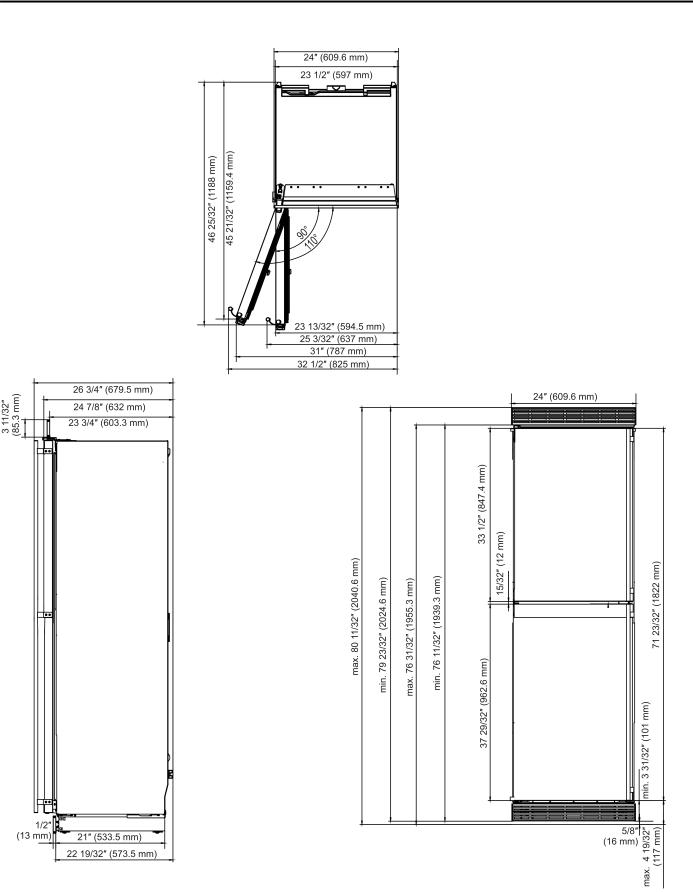
Planning information
3 Planning information
Fig. 1 Single-unit installation
|
|
|
4 |
* Depending on model and options |
|
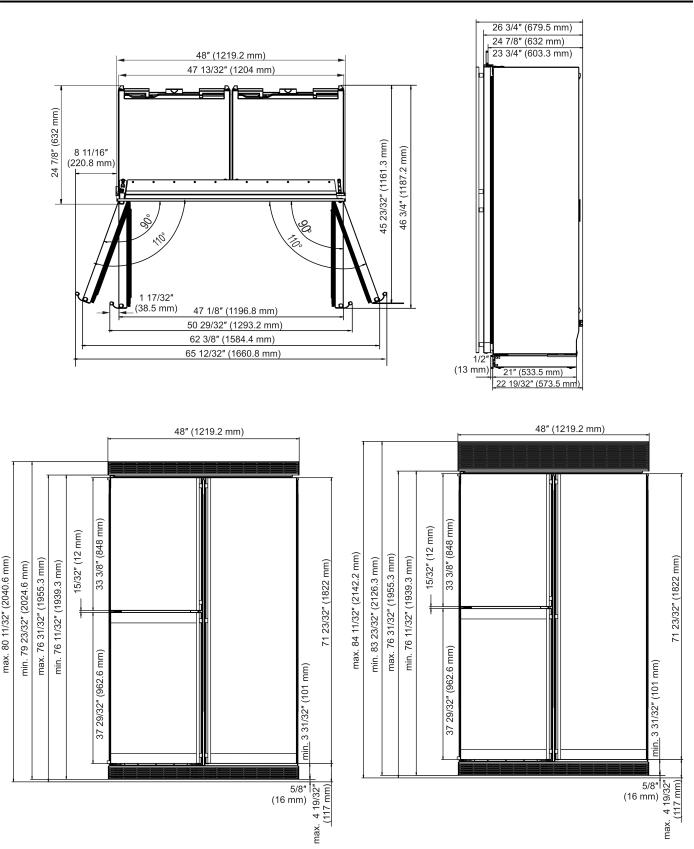
Planning information
Fig. 2 Side-by-side installation: SBS 241 and SBS 246
Fig. 3 Side-by-side installation: SBS 241 and SBS 246 with 80” or 84” ventilation grille
|
|
|
* Depending on model and options |
5 |
|
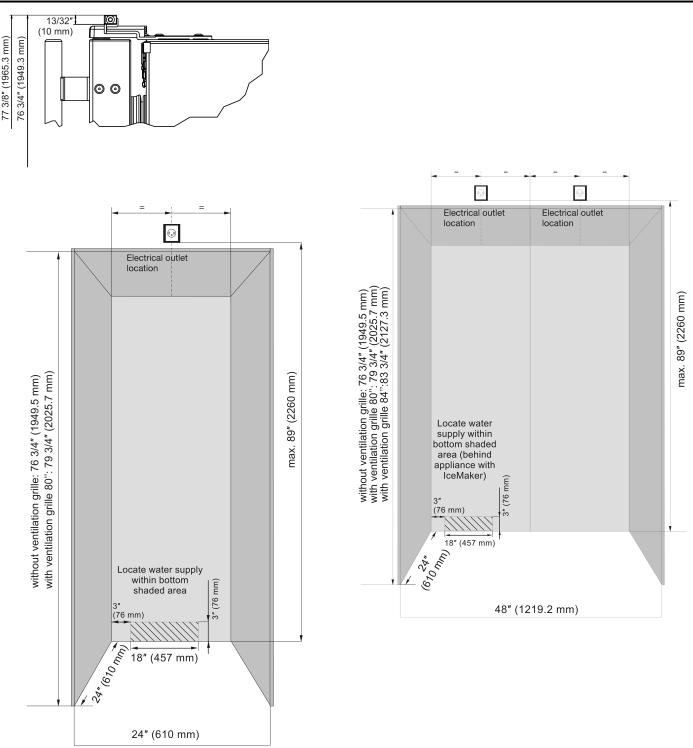
Cabinet Opening Dimensions
Fig. 4 Side-by-side installation: without ventilation grille
4 Cabinet Opening Dimensions
|
Fig. 6 Side-by-side installation: |
|
The door must be able to be opened at least 90° to allow |
|
the drawers to be pulled out properly. If the door opening |
|
angle is 90° it may be difficult to remove the drawers due |
|
to the door racks. |
|
If the appliance will be installed in a corner please leave a |
|
gap of at least 3-3/4 in. (95 mm) from the wall. |
Fig. 5 Single installation |
5 Air circulation in the kitchen |
|
cabinet |
|
This is a built-in refrigerator-freezer with stainless steel |
|
doors. |
|
|
|
6 |
* Depending on model and options |
|

Door swing clearance
The unit is not intended for freestanding use and has to be installed inside a cabinet. This type of cabinet must be carefully constructed using the proper dimensions and it must provide proper ventilation to ensure proper appliance operation.
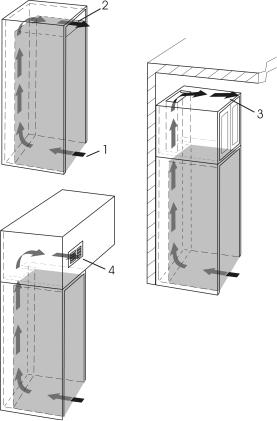 Fig. 7
Fig. 7
-An effective ventilation cross-section of at least 31 in2 (200 cm2) per unit must be present at the air intake
Fig. 7 (1) and air outlet Fig. 7 (2).
-The upper ventilation cross-section can be set up directly above the appliance with an optional ventilation grille Fig. 7 (2), near the ceiling above a cabinet Fig. 7 (3) or as an air vent in an intermediate ceiling Fig. 7 (4).
 Fig. 8
Fig. 8
- An unobstructed air way with a depth of at least 1 1/2 in. (38 mm) must be ensured at the back of the kitchen cabinet.
u The air-circulation clearances indicated above must be maintained.
6 Door swing clearance
Frameless cabinets: The casing trim overlaps the cabinets at the side and top. Cabinets may require filler strips to prevent interference with the cabinet door swing. The door opening must allow for filler strips.
The factory setting for the door to swing open is 110°. The optional setting for the door to swing open is 90°. Use the following illustrations (1:1) to ensure other cabinets or counters do not interfere with the door opening.
|
|
|
* Depending on model and options |
7 |
|

Door swing clearance
Fig. 9 110°, hinges on left
|
|
|
8 |
* Depending on model and options |
|

Door swing clearance
Fig. 10 90°, hinges on left
|
|
|
* Depending on model and options |
9 |
|

Changing the door hinges
7 Changing the door hinges
You can reverse the door hinges, if necessary:
Make sure you have the following tools on hand:
q Torx 25
q Torx 15
qScrewdriver
qCordless screwdriver, if necessary
qAnother person to help with the installation, if necessary
7.1 Remove soft stop mechanism (top)
Fig. 11
u Open upper door.
NOTICE
Risk of damage!
If the door seal is damaged the door may not close properly and the level of cooling is insufficient.
u Do not damage the door seal with the screwdriver!
u Release panel Fig. 11 (1) using slotted screwdriver and remove.
w The panel hangs above the damper bracket.
Fig. 12 u Push panel forwards over the damper bracket Fig. 12 (4)
in the direction of the appliance.
WARNING
Risk of injury if the soft stop mechanism contracts!
If the locking device is not fitted, the soft stop mechanism contracts during disassembly and can jam your fingers.
uFit the locking device!
uEngage locking device Fig. 12 (2) into place inside oblong hole.
The locking device prevents the hinge from snapping shut.
Unscrew cover that is on the hinge side Fig. 12 (5) until the first notch using a screwdriver.
The bolt will become visible.
Push bolt Fig. 12 (3) out from below.
Press damper bracket Fig. 12 (4) in the direction of the door.
Completely loosen cover that is on the hinge side and remove.
Remove panel Fig. 12 (1). Loosen cover that is on the handle side Fig. 13 (6) using a screwdriver and remove by pulling
outwards.wuwuuu Fig. 12 (5)uu
u Unscrew soft stop unit (2 x Torx 15) Fig. 12 (7).
Fig. 13
u Slightly pull out soft stop unit, push it towards the handle side and open it out.
u Set soft stop unit to the side. u Unscrew bearing part Fig. 14 (8), turn it 180° and move it to the opposite side. Make preliminary holes (optional) or use a
cordless screwdriver.
Fig. 14
7.2 Remove soft stop unit (bottom)
Fig. 15
u Open the lower door.
|
|
|
10 |
* Depending on model and options |
|

Changing the door hinges
NOTICE
Risk of damage!
If the door seal is damaged the door may not close properly and the level of cooling is insufficient.
u Do not damage the door seal with the screwdriver!
u Release panel Fig. 15 (51) using slotted screwdriver and remove.
w The panel hangs above the damper bracket.
Fig. 16 u Push panel forwards over the damper bracket
Fig. 16 (55) in the direction of the appliance.
WARNING
Risk of injury if the soft stop mechanism contracts!
If the locking device is not fitted, the soft stop mechanism contracts during disassembly and can jam your fingers.
uFit the locking device!
uEngage locking device Fig. 16 (53) into place inside oblong hole.
The locking device prevents the hinge from snapping shut.
Lift off cover Fig. 16 (52) from the outside using a screwdriver and remove by pulling outwards.
Push bolt Fig. 16 (54) out from below.
Press damper bracket Fig. 16 (55) in the direction of the door.
Remove panel Fig. 16 (51).
Unscrew entire soft stop unit (2 x Torx 15) Fig. 16 (56). Slightly pull out soft stop unit, push it towards the handle side and open it out.
Set soft stop unit to the side.wuuuuuuu
7.3 Remove upper door
u Close upper door.
Fig. 17
u Pull cover Fig. 17 (10) forward and then upwards to remove.
u Lift off cover Fig. 17 (11).
CAUTION
Risk of injury if the door tips out! u Keep a steady grip on the door. u Set the door down carefully.
u Unscrew upper bearing bracket Fig. 17 (12)(2 x Torx 25) Fig. 17 (13) and pull it upwards to remove.
u Lift the upper door upwards to remove and set it to the side.
7.4 Remove lower door
u Close the lower door.
u Remove the center bearing pin Fig. 18 (42) from the bearing bracket and the lower door.
u Remove plastic cap Fig. 18 (43).
CAUTION
Risk of injury if the door tips out! u Keep a steady grip on the door. u Set the door down carefully.
u Open the lower door.
u Detach the center bearing bracket.
u Lift lower door upwards to remove and set it to the side.
|
|
|
* Depending on model and options |
11 |
|

Changing the door hinges
7.5 To swap over central bearing parts
u Carefully remove cover trim Fig. 18 (40).
u Turn the center bearing bracket Fig. 18 (41) with protective film 180°, move it to the other side and secure tightly on the new hinge side by applying a screw torque of 3 lb-ft (4 Nm) .
u Turn the cover trim Fig. 18 (40) 180° and snap it back into place on the new handle side.
7.6 To swap over lower bearing parts
Fig. 19 u Unscrew bearing bracket Fig. 19 (20) together with bearing pin Fig. 19 (27) . When doing so, hold panel
Fig. 19 (22) steady so that it does not drop.
u Carefully lift off the cover on the handle side Fig. 19 (23) and the plug Fig. 19 (24) and move them to the opposite side.
u Unscrew screw Fig. 19 (25) and move it to the opposite side. When doing so, hold panel steady so that it does not drop.
u Unscrew bearing part Fig. 19 (28), turn it 180° and tighten Fig. 19 (29).
u Remove the bearing pin Fig. 19 (27), move it to the other side along with the bearing disc and bearing ring
Fig. 19 (26) and secure tightly to 3 lb-ft (4 Nm) .
u Using a cordless screwdriver if necessary, tightly secure Fig. 19 (21) the bearing bracket Fig. 19 (20) on the new hinge side again by applying a screw torque of 3 lb-ft (4 Nm) . First fit the lower center screw, then the other screws.
7.7 Swapping the handles
Fig. 20
u For both doors:
u Pull plugs Fig. 20 (31) out of the door bearing bushes and move them to the other side.
u Detach the door handle Fig. 20 (30) and plug Fig. 20 (32) and move them to the opposite side.
7.8 Fitting the lower door
u Position the door from above onto the lower bearing pin
Fig. 19 (27).
u Close the door.
u Place the plastic cap Fig. 18 (43) back onto the center bearing bracket Fig. 18 (41).
u Insert the center bearing pin Fig. 18 (42) on the new hinge side through the center bearing bracket Fig. 18 (41) into the lower door.
7.9 Fitting the upper door
u Position the door from above onto the center bearing pin Fig. 18 (42).
u Close the door.
u Insert the upper bearing bracket Fig. 17 (12) on the new hinge side into the door.
u Oberen Lagerbock Fig. 17 (12) fest mit 3 lb-ft (4 Nm) anschrauben (2 mal Torx 25) Fig. 17 (13). Schraublöcher evtl. vorstechen oder Akkuschrauber verwenden.
u Snap both cover Fig. 17 (10) and cover Fig. 17 (11) into place on the opposite side.
|
|
|
12 |
* Depending on model and options |
|
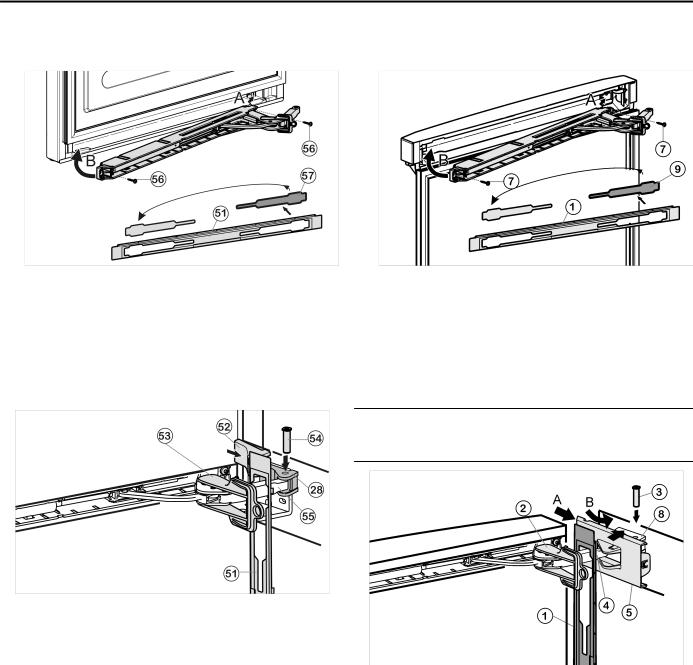
Changing the door hinges
7.10 Fitting the soft stop mechanism (bottom)
7.11 Fitting soft stop mechanism (top)
Fig. 21 u Loosen cover Fig. 21 (57) from the panel Fig. 21 (51) and
insert on the other side.
u With the hinge of the soft stop unit facing the door hinge side, engage the soft stop unit (A) and swivel inwards (B).
w The holes on the left and right must lie exactly above each other.
u Tighten soft stop unit (2 x Torx 15) Fig. 21 (56).
Fig. 22
u Hook panel Fig. 22 (51) into the damper bracket such that the detent hooks are pointing forwards and the front side is facing the appliance.
u Pull damper bracket Fig. 22 (55) towards bearing part Fig. 22 (28) and insert bolt Fig. 22 (54) from above such that the square is resting in the recess.
u Place cover Fig. 22 (52) on top and snap into place.
w Check that the cover is positioned correctly such that the door can close properly and the bolt is secured.
u Remove locking device Fig. 22 (53) by twisting it. u Snap panel Fig. 22 (51) into place on the door. u Close the door.
Fig. 23 u Loosen cover Fig. 23 (9) from the panel Fig. 23 (1) and
insert on the other side.
u With the hinge of the upper soft stop unit facing the door hinge side, engage the soft stop unit (A) and swivel inwards (B).
w The holes on the left and right must lie exactly above each other.
u Tighten soft stop unit (2 x Torx 15) Fig. 23 (7).
Note
u Follow the correct sequence. First hang the panel over the damper bracket, then the cover.
Fig. 24
u Hook panel Fig. 24 (1) into the damper bracket Fig. 24 (4) such that the detent hooks are pointing inwards and the front side is facing the appliance.
u Push on cover Fig. 24 (5) from the outside (A) and pivot over the bearing part Fig. 24 (8) (B).
u Place cover Fig. 24 (5) on top and allow to snap into place until the first notch.
w The openings for the bolts lie above each other after positioning the damper bracket.
u Pull damper bracket Fig. 24 (4) towards bearing part and insert bolt Fig. 24 (3) from above such that the square is resting in the recess.
u Now snap cover Fig. 24 (5) completely into place on the bearing part Fig. 24 (8).
|
|
|
* Depending on model and options |
13 |
|
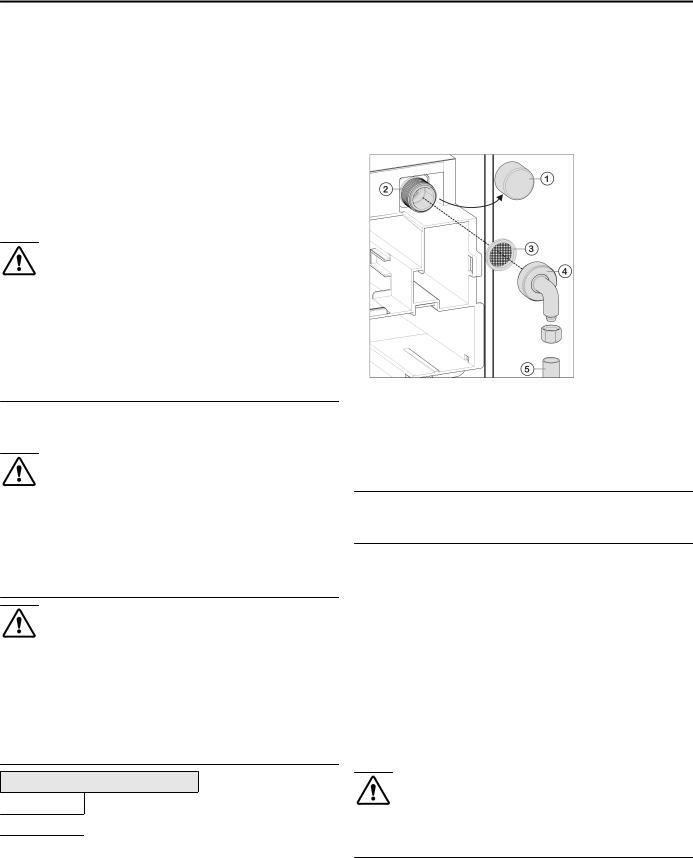
Water connection
w Check that the cover is positioned correctly such that the door can close properly and the bolt is secured.
u Remove locking device Fig. 24 (2) by twisting it. u Snap panel Fig. 24 (1) into place on the door.
u Turn cover Fig. 13 (6) 180° from the handle side, place it on top from the outside and snap into place.
7.12 Aligning the door
u Unscrew center screw on lower bearing bracket
Fig. 19 (20).
u Align the doors flush with the appliance housing using the two oblong holes in the lower bearing bracket Fig. 19 (20) and center bearing bracket Fig. 18 (41) as a guide if needed.
WARNING
Risk of bodily injury due to the door falling off.
If the bearing parts are not installed with the proper torque, the door may fall off. In addition, the door may not close, thus impairing the cooling performance of the appliance.
u Securely tighten the bearing brackets/bearing pins by applying a torque of 3 lb-ft (4 Nm).
u Check all screws and retighten if necessary.
8 Water connection
WARNING
Electrical Shock Hazard!
u Do not make the water connection while the appliance is connected to an electrical outlet.
u Disconnect the water supply before connecting the water lines for the IceMaker.
u The connection to the water supply may only be made by a trained and licensed plumber.
WARNING
Poisoning Hazard!
u The water quality must comply with the drinking water regulations for the geographical area where the appliance is located.
u The IceMaker is designed exclusively to make ice cubes in quantities needed by a household and must only be operated with water appropriate for this purpose.
Water pressure:
psi |
MPa (bars) |
21.76 to 87.02 0.15 to 0.6 (1.5 to 6)
If a water filter is used, the instructions on water pressure in the Installing the water filter section (see 13) apply.
-Water must be supplied to the appliance through a cold water pipe that complies with hygiene standards and can withstand the operating pressure.
-All devices and equipment used to supply water must comply with the regulations in force in the respective country.
-The solenoid valve is located at the bottom of the back of the appliance. It has a metric R3/4 connecting thread.
Fig. 25
u Remove the cap Fig. 25 (1) from the solenoid valve
Fig. 25 (2).
u Ensure that the gasket Fig. 25 (3) is inserted in the elbow connection Fig. 25 (4) supplied.
u Connect the elbow adapter Fig. 25 (4) to the solenoid valve Fig. 25 (2) and tighten with an open-ended wrench, for example.
NOTICE
Risk of thread damage! u Do not overtighten.
u Connect the domestic water supply Fig. 25 (5) (e.g. copper pipe) to the elbow connector Fig. 25 (4).
Before fitting into the cabinet:
u Check the whole water system for leaks. Before using for the first time:
u Have the water line bled (remove air) by a competent professional.
9 Anti-tip device
The screws for fastening the anti-tip device are not supplied with the appliance. Appropriate screws must be used for the material (wood, concrete, etc.) in which the safety device is mounted.
WARNING
Risk of injury if the appliance tips over!
u Install the anti-tip device to prevent the appliance from tipping over when the fully loaded door is open.
|
|
|
14 |
* Depending on model and options |
|

Single unit installation
NOTICE
Risk of damage due to leaking water!
If the tilt safety device has been fitted in another position than the one given, the water hoses may be damage when pushing the appliance into the niche.
u Only fit the tilt safety device in the position shown in the diagram.
Fig. 26 u Mark the installation position for the anti-tip device on
the wall or back of the unit.
u Install the anti-tip device Fig. 26 (1) using appropriate screws Fig. 26 (2).
10 Single unit installation
Make sure you have the following tools on hand:
q Torx screwdriver 10, 20
q Cordless screwdriver, if necessary q 1/4 in. bit attachment
q Spirit level
Kit 9900306 is required for the installation.
Fig. 27
The accessories kit 9900302 may be required depending on the height of the recess. (see 4)
Fig. 28
u Install anti-tipping device inside the recess (see 9) .
Fig. 29
u Screw on the upper installation contour Fig. 29 (5) by means of four screws Fig. 29 (6) inserted through the pre-cut holes in the profile and appliance.
Fit side installation strip:
|
|
|
* Depending on model and options |
15 |
|

Single unit installation
Fig. 30
u Fit retaining plate Fig. 30 (1) to the lower part of the handle side by inserting two screws Fig. 30 (2) into the pre-cut holes.
u Slide installation strip Fig. 30 (3) into the retaining plate Fig. 30 (1) from above.
u Push second retaining plate Fig. 30 (4) onto the installation strip Fig. 30 (3) from above and screw to the center of the side wall.
u Push third retaining plate Fig. 30 (4) onto the installation strip Fig. 30 (3) from above and screw to the top part of the side wall.
Note
u Depending on the recess height you will need to install a ventilation grille or an end strip. Observe the necessary ventilation cross-sections (see 5) .
Fit upper ventilation grille (80”):
Fig. 31
u Open the door.
u Position ventilation grille Fig. 31 (10) over the installation contour Fig. 31 (5) and align it such that the holes in ventilation grille and installation contour are above each other.
u Screw ventilation grille Fig. 31 (10) to installation contour Fig. 31 (5)from below using three screws Fig. 31 (11).
Install end strip:
Fig. 32
u Open the door.
u Position end strip Fig. 32 (10) over the installation contour Fig. 32 (5) and align it such that the holes in ventilation grille and installation contour are above each other.
u Screw end strip Fig. 32 (10) to installation contour Fig. 32 (5)from below using three screws Fig. 32 (11).
Secure side installation strips:
carry out the following steps for the hinge-side and the handle-side strip:
Fig. 33
u Remove adhesive tape from the side installation strip
Fig. 33 (3).
u Push installation strip Fig. 33 (3) upwards until it is touching the ventilation grille Fig. 33 (10).
u Glue the adhesive plates Fig. 33 (20) above the retaining plate Fig. 30 (1) and the retaining plates Fig. 33 (4) respectively to the installation strip Fig. 33 (3) such that it cannot slide downwards.
Install the appliance in the recess:
u Connect appliance to the water supply (see 8) . u Insert the power cable into the socket (see 14) .
|
|
|
16 |
* Depending on model and options |
|

Side-by-side installation
NOTICE
Risk of damage due to leaking water!
u When pushing the appliance into the recess ensure that the water connection does not kink or become damaged.
Fig. 34
u Push the appliance into the recess until the rear edge of the ventilation grille Fig. 34 (10) is flush with the front edge of the side wall of the cabinet.
u Open the door.
NOTICE
Risk of damage to the castors.
u Do not use a power tool to adjust the leveling rollers as it will damage the leveling mechanism or disengage the rod – instead use a hand ratchet.
u Align appliance inside the recess above the roller bases Fig. 34 (33) using a spirit level: Use upper adjustment setting (1/4”) Fig. 34 (34) for the rear adjustable foot and lower adjustment setting (1/4”) Fig. 34 (35) for the front adjustable foot respectively. Turn clockwise to raise and counterclockwise to lower. Maximum adjustable height: 5/8 in (16 mm).
u At the top and bottom of the recess check the gap A between the front edge of the installation strip Fig. 34 (3) and the front edge of the side wall of the unit. It must be 1/2 ” (13 mm). Realign the appliance in the recess if required.
u Secure appliance inside the recess using three screws Fig. 34 (30) on the handle side and the hinge side respectively. Do not scratch the side installation strip Fig. 33 (3) when doing so.
u Place cover caps Fig. 34 (31) over the screws.
Fig. 35
If a water filter is used:
u Insert water filter (see 13) . If no water filter is used:
u Fit lower ventilation grille Fig. 35 (32) flush with the floor such that the rubber lip is at the top. It is held in place via magnets.
u If necessary set the door opening angle (see 12) .
11 Side-by-side installation
The appliance with the ice maker must be on the left when viewed from the front, the refrigerator unit on the right.
Make sure you have the following tools on hand:
q Torx screwdriver 10, 15, 20, 25
q Cordless screwdriver, if necessary q 1/4 in. bit attachment
q Spirit level
Fig. 36
Kit 9900308 is required for the installation.
|
|
|
* Depending on model and options |
17 |
|

Side-by-side installation
Fig. 37
Fig. 38
The accessories kit 9900304 or 9900344 may be required depending on the height of the recess. (see 4)
u Install anti-tipping device inside the recess (see 9) .
Fit side installation strips:
If the side on which the door hinges are located has been changed, move the side installation strip to the hinge side for both appliances.
Fig. 40
u Position the appliances next to each other with a gap of approximately 13/32 '' (10 mm) such that they are flush at the front.
u Open the door.
Fig. 39
u Unscrew retaining plates Fig. 39 (1,4) and remove rail
Fig. 39 (3).
u Fit retaining plate Fig. 39 (1) to the lower part of the hinge side by inserting two screws Fig. 39 (2) into the pre-cut holes.
u Slide rail Fig. 39 (3) into the retaining plate Fig. 39 (1) from above.
u Push second retaining plate Fig. 39 (4) onto the rail from above and screw onto the center of the side wall.
u Push third retaining plate Fig. 39 (4) onto the rail from above and screw onto the top part of the side wall.
Join appliances:
Fig. 41
u Loosen covers Fig. 41 (10) using a screwdriver and pull inwards to remove.
|
|
|
18 |
* Depending on model and options |
|
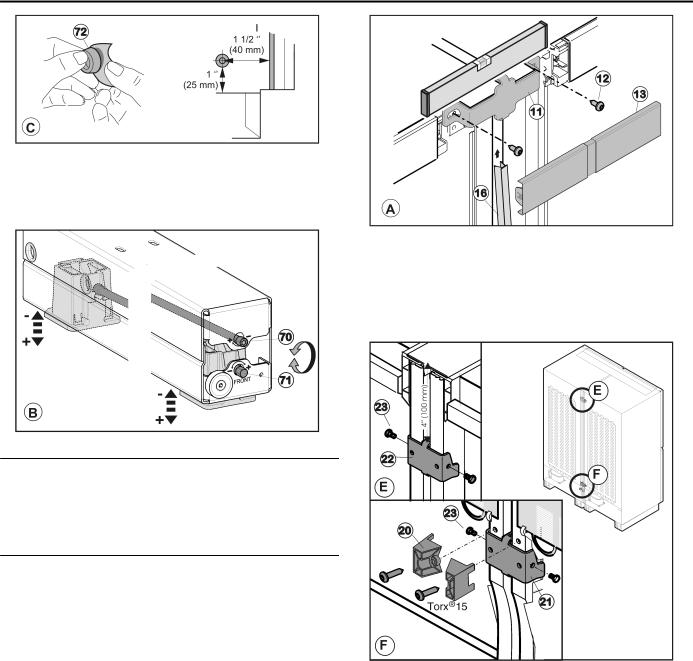
Side-by-side installation
Fig. 42
u Glue spacer Fig. 42 (72) onto the lower part of the side wall on the handle side, approximately 1.5 in. (40 mm) as measured inwards from the front edge of the appliance.
Fig. 44
u Secure upperconnecting element Fig. 44 (11) using two screws Fig. 44 (12). Make preliminary holes (optional) or use a cordless screwdriver.
u Clip on cover panel Fig. 44 (13).
u Push appliances together at the bottom and realign if necessary.
Fig. 43
NOTICE
Risk of damage to the castors.
u When aligning appliance do not use a cordless screwdriver on the castors or the height adjustment mechanism will be damaged or the adjusting rod may come loose. Adjust the castors by hand.
u Align the height of both appliances evenly using the four roller bases. Use the upper adjustment setting (1/4") Fig. 43 (70) for the rear adjustment foot and the lower adjustment setting (1/4") Fig. 43 (71) for the front adjustment foot. Turn clockwise to raise and counterclockwise to lower. Maximum adjustable height: 5/8 in (16 mm).
u Position end strip Fig. 40 (14) over the installation contour and align it such that the holes in ventilation grille and installation contour are above each other.
u Screw on upper installation contour Fig. 40 (14) through the pre-cut holes using screws Fig. 42 (15).
Fig. 45 |
|
|
|
|
|
|
|
u Remove the spacers Fig. 45 (20) from the lower reverse |
|||||||
side of the appliances. |
connecting |
piece |
and |
||||
u Position |
the |
upper |
|||||
Fig. 45 |
(23)screw Fig. 45 (21) on from the side. |
and screw |
|||||
u Position upper connecting piece Fig. 45 (22) |
|||||||
Fig. 45 |
(23) on from the side. |
|
|
|
|
||
|
|
|
* Depending on model and options |
19 |
|
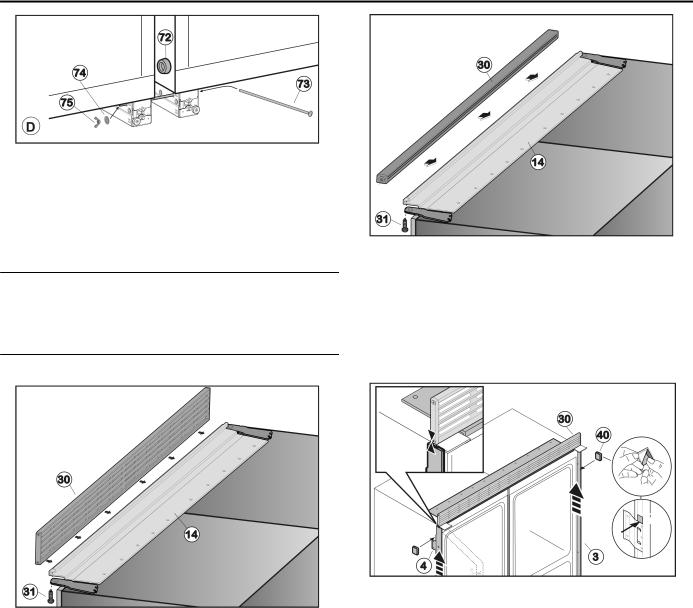
Side-by-side installation
Fig. 46
u Insert long carriage bolt Fig. 46 (73).
u Push washer Fig. 46 (74) and nut Fig. 46 (75) onto the screw. Tighten nut until the spacer Fig. 46 (72) is touching the opposite side wall.
u Fit strip Fig. 44 (16), push it slightly under the top cover Fig. 44 (13) and then press it downwards into the gap.
u Tighten the screws Fig. 45 (23).
Note
u Depending on the recess height, you will need to install a ventilation grille (80”), a ventilation grille (84”) or an end strip. Observe the necessary ventilation crosssections (see 5) .
Fit upper ventilation grille (80 or 84”):
Fig. 47
u Open the door.
u Position ventilation grille Fig. 47 (30) over the installation contour Fig. 40 (14) and align it such that the holes in ventilation grille and installation contour are above each other.
u Screw ventilation grille Fig. 47 (30) to installation contour from below using four screws Fig. 47 (31).
Fit end strip:
Fig. 48
u Open the door.
u Position end strip Fig. 48 (30) over the installation contour Fig. 40 (14) and align it such that the holes in ventilation grille and installation contour are above each other.
u Screw end strip Fig. 48 (30) to installation contour from below using four screws Fig. 48 (31).
Secure side installation strip:
Fig. 49
u Remove adhesive tape from the side installation strip
Fig. 49 (3).
u Push installation strip Fig. 49 (3) upwards until it is touching the ventilation grille Fig. 49 (30).
u Glue the adhesive plates Fig. 49 (40) above the retaining plate Fig. 39 (1) and the retaining plates Fig. 49 (4) respectively to the installation strip Fig. 49 (3) such that it cannot slide downwards.
Install the appliance in the recess:
u Connect appliance to the water supply (see 8) . u Insert the power cable into the socket (see 14) .
|
|
|
20 |
* Depending on model and options |
|

Adjusting the door opening angle
Fig. 50
u Push the appliance into the recess until the rear edge of the ventilation grille Fig. 50 (30) is flush with the front edge of the side wall of the cabinet.
u Open the door.
u Completely screw in the two centre roller bases Fig. 50 (50) at the front and rear such that the appliance is only resting on the outer roller bases. This enables the two appliances connected to each other to be aligned jointly like a single appliance.
u Align appliance inside the recess by adjusting the outer roller bases Fig. 50 (51) and using a spirit level.
u At the top and bottom of the recess check the gap A between the front edge of the installation strip Fig. 50 (3) and the front edge of the side wall of the unit. It must be 1/2 ” (13 mm). Realign the appliance in the recess if required.
u Secure appliance inside the recess using three screws Fig. 50 (52) hinge side of each appliance. Do not scratch the side installation strip Fig. 50 (3) when doing so.
u Place cover caps Fig. 50 (53) over the screws.
u Being careful not to affect the level, lower the levelling wheels in the center roller bases Fig. 50 (50) until they are resting on the floor.
Fig. 51
If a water filter is used:
u Insert the water filter (see 13) . If no water filter is used:
u Fit lower ventilation grille Fig. 50 (54) flush with the floor such that the rubber lip is at the top. It is held in place via magnets.
u If necessary set the door opening angle (see 12) .
12 Adjusting the door opening angle
The appliance is delivered with a door opening angle of 110°. If the angle needs to be limited to 90° an opening limiter must be used on the soft stop mechanism. Carry out the following steps for all soft stop mechanisms on the appliance (the top soft stop mechanism is illustrated):
NOTICE
Risk of damage for the door!
If no opening limiter is fitted and the door is opened, it can hit the side installation strip and scratch as a result. For this reason the appliance is already equipped with an opening limiter (110°) as delivered from the factory.
u Always fit an opening limiter (110° or 90°)!
u When fitting the opening limiter open the door carefully and do not allow it to hit anything!
Removing the soft stop unit u Open the door.
Fig. 52
NOTICE
Risk of damage!
If the door seal is damaged the door may not close properly and the level of cooling is insufficient.
u Do not damage the door seal with the screwdriver!
|
|
|
* Depending on model and options |
21 |
|
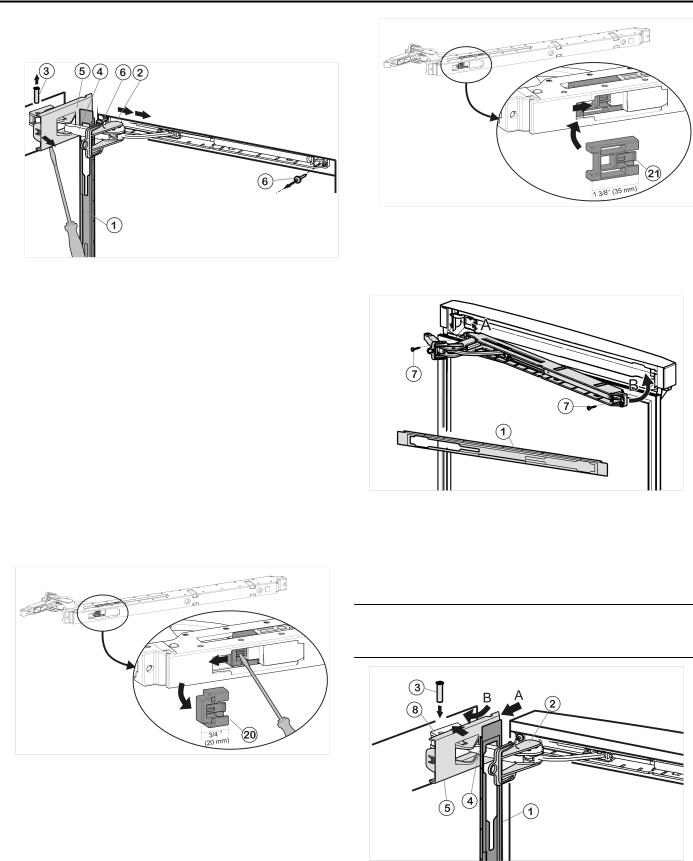
Adjusting the door opening angle
u Release panel Fig. 52 (1) using slotted screwdriver and remove.
w The panel hangs above the damper bracket.
Fig. 53 u Push panel forward over the damper bracket Fig. 53 (4)
in the direction of the appliance.
u Engage locking device Fig. 53 (2) into place inside oblong hole.
w The locking device prevents the hinge from snapping shut.
u Unscrew cover that is on the hinge side Fig. 53 (5) until the first notch using a screwdriver.
w The bolt will become visible.
u Push bolt Fig. 53 (3) out from below.
u Press damper bracket Fig. 53 (4) in the direction of the door.
u Completely loosen cover that is on the hinge side
Fig. 53 (5) and remove. u Remove panel Fig. 53 (1).
u Unscrew soft stop unit (2 x Torx 15) Fig. 53 (6).
u Slightly pull out soft stop unit, push it towards the handle side and open it out.
Fit opening limiter:
Fig. 54
u Remove opening limiter (110°) Fig. 54 (20) on soft stop mechanism: Press down notch using screwdriver and pull off opening limiter Fig. 54 (20).
Fig. 55 u Fit opening limiter (90°) Fig. 55 (21) supplied: insert it into the soft stop mechanism from the side and push in
until it audibly snaps into place.
Re-attaching the soft stop mechanism:
Fig. 56
u With the hinge of the upper soft stop unit facing the door hinge side, engage the soft stop unit (A) and swivel inwards (B).
w The holes on the left and right must lie exactly above each other.
u Tighten soft stop unit (2 x Torx 15) Fig. 56 (7).
Note
u Follow the correct sequence. First hang the panel over the damper bracket, then the cover.
Fig. 57
|
|
|
22 |
* Depending on model and options |
|
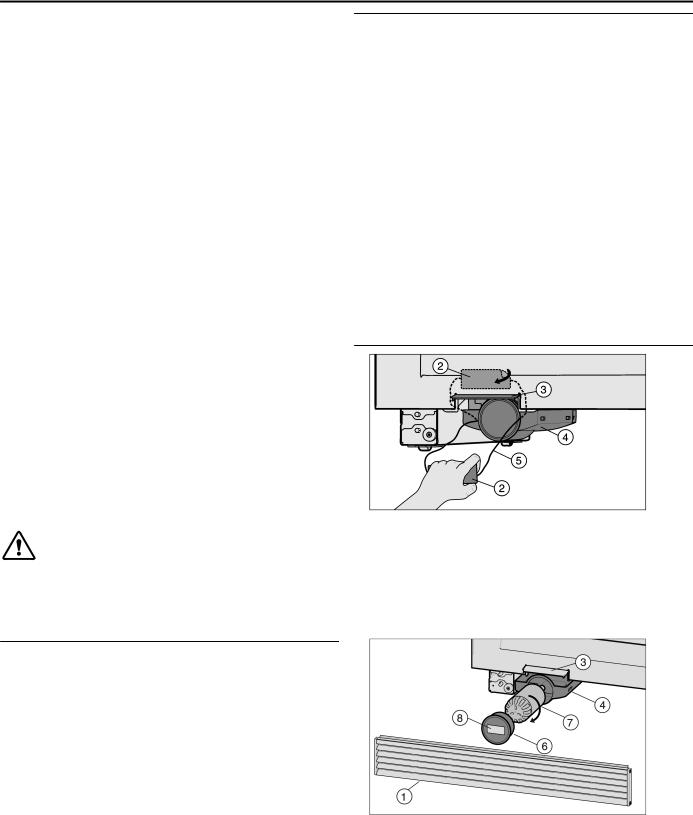
Installing the water filter
u Hook panel Fig. 57 (1) into the damper bracket Fig. 57 (4) such that the detent hooks are pointing inwards and the front side is facing the appliance.
u Push on cover Fig. 57 (5) from the outside (A) and pivot over the bearing part Fig. 57 (8) (B).
u Place cover Fig. 57 (5) on top and allow to snap into place until the first notch.
w The openings for the bolts lie above each other after positioning the damper bracket.
u Pull damper bracket Fig. 57 (4) towards bearing part and insert bolt Fig. 57 (3) from above such that the square head is resting in the recess.
u Now snap cover Fig. 57 (5) completely into place on the bearing part Fig. 57 (8).
w Check that the cover is positioned correctly such that the door can close properly and the bolt is secured.
u Remove locking device Fig. 57 (2) by twisting it. u Snap panel Fig. 57 (1) into place on the door.
13 Installing the water filter
The water filter guarantees optimal water quality and should be installed the first time you use the appliance.
Alternatively, the appliance can also be operated without the water filter.
Flow rate |
0.5 gpm (1.89 lpm) |
Water connection |
Drinking water |
Water pressure |
40 psi - 90 psi ( 2.8 bar - 6.2 bar/ 0.28 MPa |
|
- 0.62 MPa ) |
Water temperature |
33 °F - 100 °F ( 0.6 °C - 37 °C ) |
Capacity |
300 gal. (1.14 l) |
|
|
WARNING
Consuming contaminants can be harmful to your health! u If there is a chance the water may contain harmful
bacteria or if the water quality is unknown, do not use this system without appropriate disinfection measures upstream or downstream of the system.
NOTICE
Leakage water may damage the system!
u Do not install this system on hot water lines. The maximum operating temperature of the water in this system is 100 °F (37.7 °C).
u This system MUST be installed and used in compliance with federal and local installation regulations.
u Do not install under water hammer conditions. A water hammer arrestor must be used to prevent water hammering. If you are unsure how to check these conditions, consult a professional installer.
u Do not install with a water pressure greater than 90 psi (6.2 bar). If your water pressure exceeds 80 psi, install a pressure limiting valve. If you are unsure how to check the water pressure, consult a professional installer.
u Protect against frost; if temperatures below 33 °F (0.6 °C) are expected, remove the filter.
u When used as indicated, the disposable filter cartridges must be replaced every 6 months or whenever you notice a considerable decrease in the flow rate.
u If necessary, remove ventilation grille Fig. 59 (1). |
|
||||
u Remove any labels Fig. 58 (2) from the appliance. |
|
||||
u Open the filter change flap Fig. 58 (3). |
by |
the |
string |
||
u Carefully pull out |
drawer |
Fig. 58 (4) |
|||
Fig. 58 (5). |
Fig. 58 |
(5) together |
with |
the |
label |
u Cut off the string |
|||||
Fig. 58 (2) and pull out. It is no longer required and can be disposed of.
u Remove the filter cover Fig. 59 (6).
u Insert water filter Fig. 59 (7) and turn it approximately 100° clockwise as far as it will go.
u Insert the drawer Fig. 59 (4).
u Place the cover Fig. 59 (6) on the filter.
|
|
|
* Depending on model and options |
23 |
|
